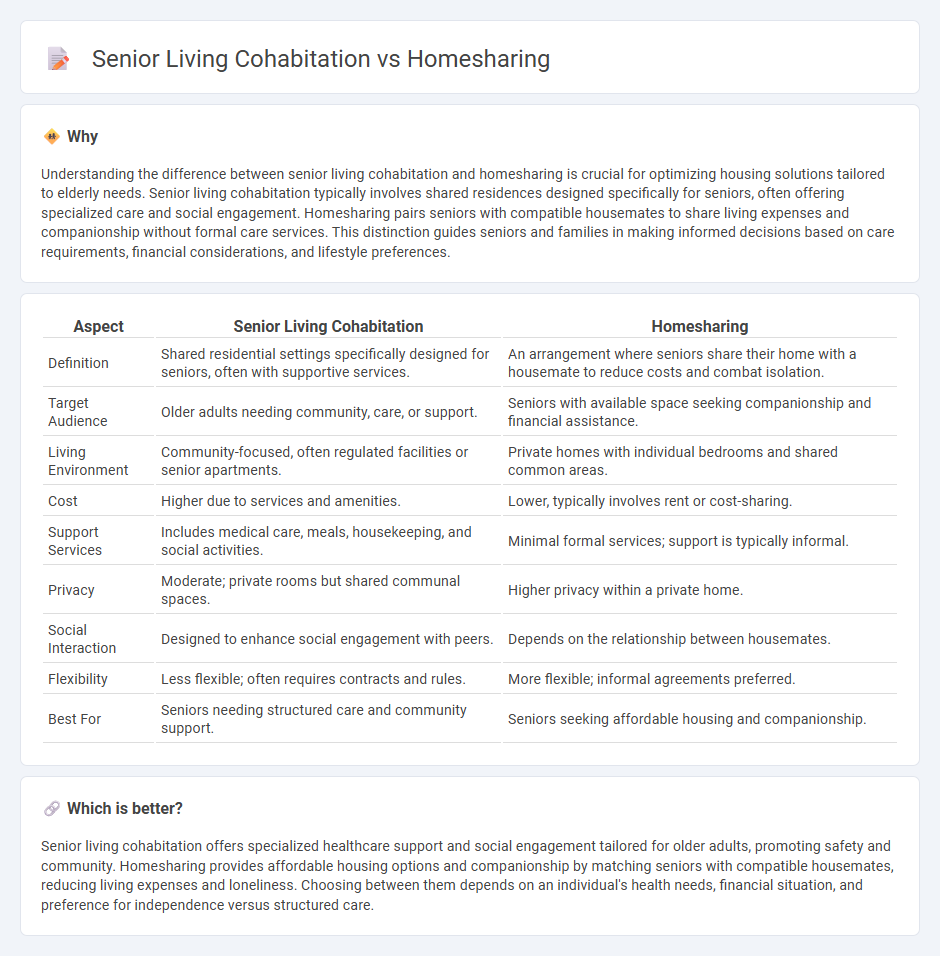
Senior living cohabitation offers older adults the chance to share a home with peers for companionship and cost savings, while homesharing pairs seniors with compatible housemates, often providing intergenerational support. Both models enhance affordability and social connectedness, addressing isolation and housing expenses prevalent among the elderly. Explore the benefits and differences of senior living cohabitation versus homesharing to find the best fit for aging in place.
Why it is important
Understanding the difference between senior living cohabitation and homesharing is crucial for optimizing housing solutions tailored to elderly needs. Senior living cohabitation typically involves shared residences designed specifically for seniors, often offering specialized care and social engagement. Homesharing pairs seniors with compatible housemates to share living expenses and companionship without formal care services. This distinction guides seniors and families in making informed decisions based on care requirements, financial considerations, and lifestyle preferences.
Comparison Table
| Aspect | Senior Living Cohabitation | Homesharing |
|---|---|---|
| Definition | Shared residential settings specifically designed for seniors, often with supportive services. | An arrangement where seniors share their home with a housemate to reduce costs and combat isolation. |
| Target Audience | Older adults needing community, care, or support. | Seniors with available space seeking companionship and financial assistance. |
| Living Environment | Community-focused, often regulated facilities or senior apartments. | Private homes with individual bedrooms and shared common areas. |
| Cost | Higher due to services and amenities. | Lower, typically involves rent or cost-sharing. |
| Support Services | Includes medical care, meals, housekeeping, and social activities. | Minimal formal services; support is typically informal. |
| Privacy | Moderate; private rooms but shared communal spaces. | Higher privacy within a private home. |
| Social Interaction | Designed to enhance social engagement with peers. | Depends on the relationship between housemates. |
| Flexibility | Less flexible; often requires contracts and rules. | More flexible; informal agreements preferred. |
| Best For | Seniors needing structured care and community support. | Seniors seeking affordable housing and companionship. |
Which is better?
Senior living cohabitation offers specialized healthcare support and social engagement tailored for older adults, promoting safety and community. Homesharing provides affordable housing options and companionship by matching seniors with compatible housemates, reducing living expenses and loneliness. Choosing between them depends on an individual's health needs, financial situation, and preference for independence versus structured care.
Connection
Senior living cohabitation and homesharing both address the growing demand for affordable, community-oriented housing solutions for older adults, enhancing social interaction and reducing loneliness. These models optimize underutilized residential spaces, allowing seniors to share homes while maintaining independence and access to support services. By blending economic efficiency with personalized care, cohabitation and homesharing improve quality of life and foster sustainable housing options in the real estate market.
Key Terms
Lease Agreement
Homesharing lease agreements typically emphasize flexible terms, shared responsibilities, and clearly defined private and common living spaces to accommodate diverse tenant needs. Senior living cohabitation leases often include specific provisions addressing health care, accessibility requirements, and compliance with senior housing regulations. Explore detailed comparisons to understand which lease structure best aligns with your living preferences and legal protections.
Age Restriction
Homesharing programs typically impose flexible age restrictions, often targeting adults over 55 or seniors looking to share housing for affordable living and companionship. In contrast, senior living cohabitation communities generally enforce strict age limits, commonly requiring residents to be 62 years or older to qualify for residence and support services tailored to aging populations. Explore further differences in age policies and benefits between these housing options to find the best fit for your needs.
Shared Amenities
Homesharing and senior living cohabitation both emphasize shared amenities to enhance social interaction and cost-efficiency among residents. Homesharing typically involves private bedrooms with common access to kitchens, living rooms, and bathrooms, promoting flexible and personalized living arrangements. Explore detailed comparisons of shared spaces to find the best fit for lifestyle and budget preferences.
Source and External Links
HomeSharing - HomeSharing creates affordable housing solutions by matching individuals seeking housing with those needing additional income or services to maintain their homes.
Homesharing - Homesharing is an arrangement where two unrelated people share a home, providing companionship and mutual support, not solely for financial gain.
Homeshare - Homeshare involves exchanging housing for help in the home, offering solutions for those needing affordable housing and those requiring support to live independently.
 dowidth.com
dowidth.com